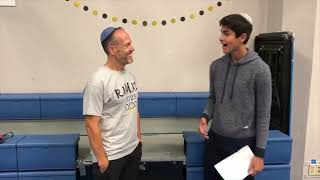A Yearbook to Remember
Yearbooks weren’t always about sports, Shabbatons, and seniors. The first yearbooks in the 1600s were described as an individual’s compilation of memories and aspirations for the future. Students would write notes to friends and store keepsakes to look back on. Yearbooks then became official school souvenirs in 1806 when Yale printed an end of year yearbook. In fact, photos were scarce in the first yearbooks. Cameras were rare and didn’t capture events like our cameras do today. Schools were lucky if students were able to receive even a single photo of their entire grade.
Over time, yearbooks became more multidimensional with jokes, art, and lots of pictures. Yearbooks are made to be a reminder, at some time in the future, of classmates, teachers, and school activities. More often than not, old yearbooks can be found in piles of storage in the back of a bookshelf and are only looked at a few times in a person’s life. On occasion, however, a yearbook may memorialize a significant historical event like the attacks of 9/11 or the moon landing; such yearbooks are more valuable as they provide a broader context to the student’s set of experiences. This year’s Ramaz yearbook club has the opportunity to make a great yearbook that will forever remind us of the global historic pandemic that has impacted the entire world beginning in early 2020. While the pandemic interrupted the 2019-2020 academic year, the impact it had on the yearbook was minimal. Thus, given the ongoing pandemic, the 2021 yearbook itself will be a unique resource that documents the effects of the SARS-CoV-2 and COVID-19 on our lives.
In previous years, yearbooks were full of pictures of school events, clubs, and school jokes. But, given the COVID-19 circumstances, how will this year’s yearbooks look? With social distancing guidelines to prevent us from being in pictures together, and with no school-wide events, sports, or any in-school clubs, how will the yearbook team develop content?
In an interview with Yearbook editors Avigail Dupont ‘21 and Lauren Lepor ‘21, I learned about the plans for this year’s yearbook. While hybrid learning is in effect, the yearbook team is “trying to make the most of our time in the building and trying to get as much content and pictures (Avigail ‘21)” as possible. Lauren explained that “there will be a lot more mini mags because there are no major events that are happening anytime soon. So, in order to fill pages [of the yearbook] we are planning on filling pages with fun things for everyone to see”. For instance, the yearbook will have more student spotlights and art. While the editors want to maintain “a sense of normalcy” there will definitely be significant Coronavirus and Zoom related content.
As a community, we have been socially isolated for the past six months and have managed to maintain connection and community. Yearbook editor Avigail says that “through this yearbook, we want to show that even with all the distancing regulations and even when we can’t really be a community, we still are a community.” The yearbook is a vital part of our Ramaz community. Like yearbooks of the past, this yearbook will have the important role of reminding students of all the challenges that were overcome. While this school year may be different and challenging, the yearbook will focus on the positive aspects of the school year.




